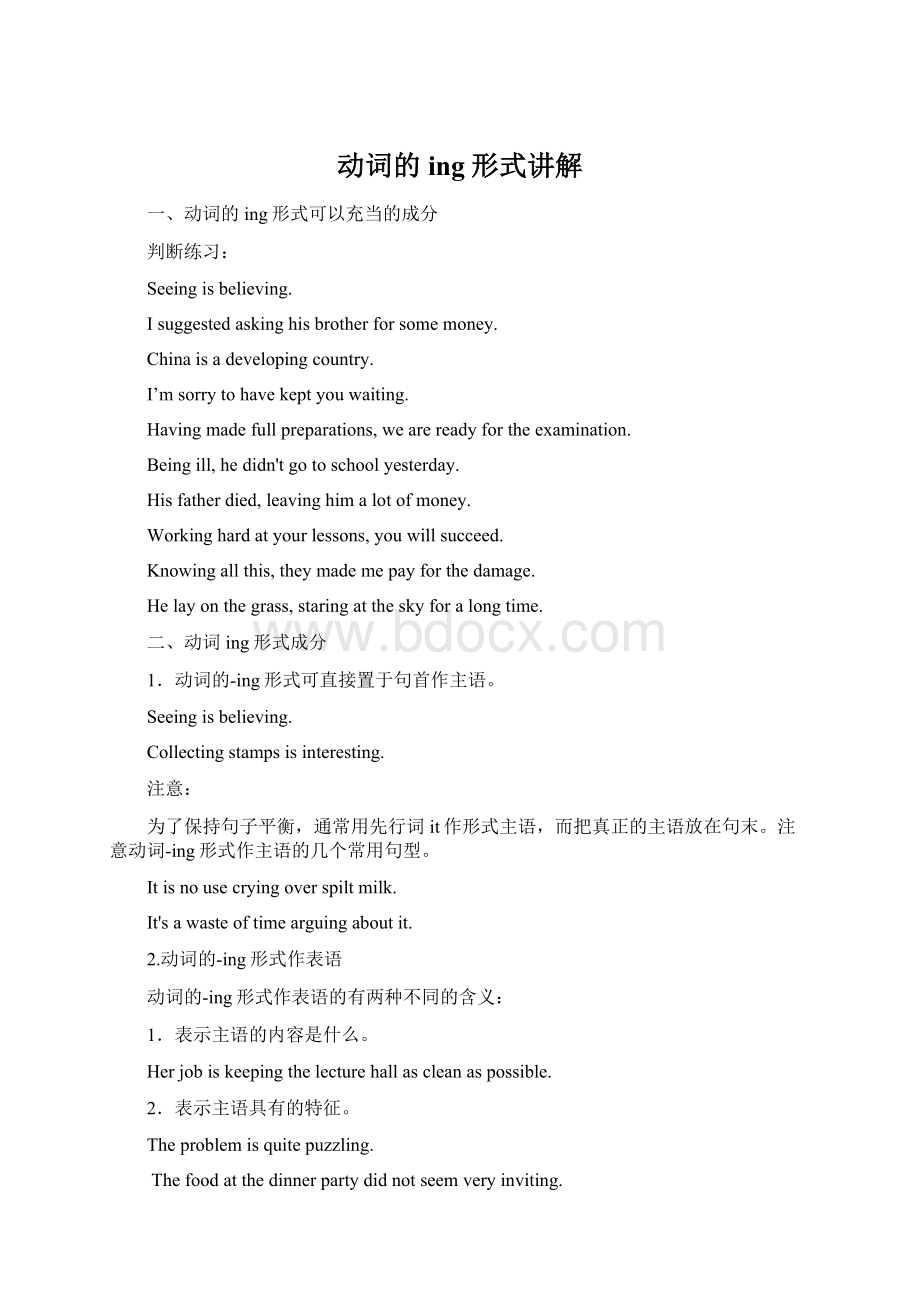动词的ing形式讲解.docx
《动词的ing形式讲解.docx》由会员分享,可在线阅读,更多相关《动词的ing形式讲解.docx(13页珍藏版)》请在冰豆网上搜索。

动词的ing形式讲解
一、动词的ing形式可以充当的成分
判断练习:
Seeingisbelieving.
Isuggestedaskinghisbrotherforsomemoney.
Chinaisadevelopingcountry.
I’msorrytohavekeptyouwaiting.
Havingmadefullpreparations,wearereadyfortheexamination.
Beingill,hedidn'tgotoschoolyesterday.
Hisfatherdied,leavinghimalotofmoney.
Workinghardatyourlessons,youwillsucceed.
Knowingallthis,theymademepayforthedamage.
Helayonthegrass,staringattheskyforalongtime.
二、动词ing形式成分
1.动词的-ing形式可直接置于句首作主语。
Seeingisbelieving.
Collectingstampsisinteresting.
注意:
为了保持句子平衡,通常用先行词it作形式主语,而把真正的主语放在句末。
注意动词-ing形式作主语的几个常用句型。
Itisnousecryingoverspiltmilk.
It'sawasteoftimearguingaboutit.
2.动词的-ing形式作表语
动词的-ing形式作表语的有两种不同的含义:
1.表示主语的内容是什么。
Herjobiskeepingthelecturehallascleanaspossible.
2.表示主语具有的特征。
Theproblemisquitepuzzling.
Thefoodatthedinnerpartydidnotseemveryinviting.
比较:
一般说来,动词的-ing形式表示一般性、习惯性或抽象性的动作,时间概念不强。
而动词不定式表示的动作往往是具体的或一次性的动作,特别是将来的动作。
Theypreferstayingindoorswhentheweatheriscold.(泛指)
Wouldyouprefertostayathomethisevening.(具体)
[考例]1. Thespeechwasvery______,andwewere______totears.
A.moved;moved B.moving;movingC.moving;movedD.moved;moving
[考例]2. Herjobis_____allthechildren.
A.lookafter B.lookingafter C.tolookafter D.havinglookafter
3.动词的-ing形式作宾语:
动词的-ing形式既可作及物动词的宾语,也可作介词的宾语。
1.作动词的宾语
①只能用-ing形式作宾语的动词
这类动词只能用-ing形式作宾语,不能用不定式作宾语。
eg:
Isuggestdoingitinadifferentway.
注意:
只接动词的-ing形式而不接不定式作宾语的动词有:
admit承认appreciate感激avoid避免consider考虑delay耽搁enjoy喜欢escape避免excuse原谅feellike意欲finish完成forgive原谅giveup放弃cannothelp情不自禁imagine设想keep保持mention提及mind介意miss逃过putoff推迟practice练习risk冒险
②既可用动词-ing形式作宾语,也可用不定式作宾语
这类动词虽然既能用-ing形式作宾语,也能用不定式作宾语,但用法并不相同,主要有以下几种情况:
a.有些动词,如continue,hate,intend,like,love,prefer等,后面接动词的-ing形式或不定式区别不是很大。
Theypreferspending/tospendtheirsummervacationinDalian.
Iintendtobuy/buyinganEnglish-Chinesedictionary.
b、跟不定式和动词的-ing形式皆可,但意义相差很大的动词
这类动词常用的有:
①try:
trytodosth.尽力做难做的事;
trydoingsth.试着做某一件可能会出现某一结果的事。
Hetriedtostandupbutfailed.
Let’strytellinghimaboutthesadnews.
②regret:
regrettodosth.对马上要做的事表示遗憾;
regretdoingsth.对已发生的事表示遗憾或后悔。
Ireallyregretmissing/havingmissedhislecture.
IregrettotellyouthatIcannotcome.
③can’thelp:
can’thelpdoingsth.禁不住;
can’thelp(to)dosth.不能帮忙干…
Icouldn’thelpshakingwithsofewclotheson.
Ican’thelptocleantheplaceup.
④mean:
meantodosth. 想做;
meandoingsth.意味着。
如:
Wastingtimemeanskillinglife.
Revolutionmeansliberatingtheproductiveforces.
⑤forget:
forgetdoingsth.忘了已做过的事;
forgettodosth.忘记将要做的事。
如:
Iforgottellinghimaboutthenews.
Don’tforgettowakemeupat6tomorrowmorning.
⑥goon:
goondoingsth.继续干未干完的事(强调动作的持续);
goontodosth.继续干另一件事(强调事情的转接)
Theoldmanwentondoinghisworkafterashortrest.
Theoldmanwentontoplayanothersong.
⑦remember:
rememberdoingsth.指记着做过的事;
remembertodosth.记着要做事。
如:
Pleaseremembertocomeontime.
IstillrememberbeingtakentotheScienceMuseumforthefirsttime.
⑧stop:
stoptodosth. 停下正在做的动作去做另一动作;
stopdoingsth.停止做动名词所表示的动作。
如:
Westopped(inorder/soas)tohavearest.
Don’tstoptryingonceagain.
c.need,require,want作“需要”解时,后面接-ing形式的主动形式或不定式的被动形式,意义上并无差别,但用-ing形式比较普通。
Yourcompositionneedscorrecting/tobecorrected.
Hiscoatwantscleaning/tobecleaned.
Theoldwomanrequireslookingaftercarefully/tobelookedaftercarefully.
[考例]1.Themaninsisted_____ataxiformeeventhoughItoldhimIlivednearby.
A.find B.tofind C.onfinding D.infinding
[考例]2.----Youwerebraveenoughtoraiseobjectionsatthemeeting.
-----Well,nowIregret_____that.
.todo B.tobedoing C.tohavedone D.havingdone
4.动词的-ing形式作宾语补足语
1.动词的-ing形式可以在see,hear,notice,watch,feel,smell,lookat,listento,observe,find等表示感官和心理状态的动词后面作宾语补足语.
Weheardthechildrenshoutingupstairs.
2.动词的-ing形式和不定式作宾语补语的区别
在see,hear,feel,watch,notice等感官动词后,既可用动词的-ing形式构成复合宾语,也可用不定式构成复合宾语,两者之间有一定的区别。
用动词的-ing形式时,表示动作正在进行;用不定式时,表示动作发生了,即动作的全过程结束了。
Hesawagirlgettingonthecar. (Shewasgettingonthecar.)
Hesawagirlgetonthecaranddriveoff.(Shegotonthecaranddroveoff.)
3.动词的-ing形式也可用在have,get,leave,keep,set,catch等表示“致使”的动词后作宾语补足语。
Theyshouldnotleaveuswonderingwhattheywilldonext.
[考例]1.Helookedaroundandcaughtaman______hishandintothepocketofapassenger.
A.put B.tobeputting C.toput D.putting
[考例]2.Don’tleavethewater______whileyoubrushyourteeth.
A.run B.running C.beingrun D.torun
5.动词的-ing形式作定语
1.单个的动词的-ing形式可以作前置定语,一般有两种含义。
①说明被修饰名词的用途和性能。
asewingmachine 缝纫机 aswimmingpool 游泳池 adiningcar 餐车
awalkingstick 手杖awaitingroom 候车室
②表示所修饰的人或物的动作或状态,在意思上接近一个定语从句,可以表示正在进行的动作,也可表示经常性动作或当时的状态。
adisappointingplay令人失望的戏剧 anastonishingadventure惊人的冒险
boilingwater正在沸腾的水asleepingbaby 熟睡的婴儿failingsight 逐渐衰退的视力
2.作定语的-ing形式如是一个短语,则应放在被修饰词的后面。
Thebottlecontainingvinegarshouldbesenttothelaboratory.
Theylivedinahousefacingsouth.
3.有些情况下,动词的-ing形式不能用来作定语,必须使用定语从句。
①作定语的-ing形式表示的动作要与主句谓语的动作同时发生,如两者不能同时发生的话,则需使用定语从句。
【误】Theprofessorcominghereyesterdaywillgiveusalecture.
【正】Theprofessorwhocamehereyesterdaywillgiveusalecture.
②-ing形式的完成式一般只用来作状语,不作定语。
【误】Thetemplehavingbeendestroyedbytheearthquakewillberebuiltsoon.
【正】Thetemplewhichhasbeendestroyedbytheearthquakewillberebuiltsoon.
[考例]1.Mr.Smith,________ofthe______speech,startedtoreadanovel.
A.tired;boring B.tiring;bored C.tired;bored D.tiring;boring
[考例]2.WhenIgotbackhomeIsawamessagepinnedtothedoor______“Sorrytomissyou;Iwillcalllater.”
A.read B.reads C.toread D.reading
6.动词的-ing形式作状语
动词的-ing形式可以作状语,修饰动词,在句中表示时间、原因、结果、条件、让步、行为方式或伴随情况等。
-ing形式作时间、原因、条件、让步状语时多位于句首;作结果、伴随情况状语时常位于句末。
1.表示时间,相当于一个时间状语从句。
Seeingthosepictures,sherememberedherchildhood.
(=Whenshesawthosepictures...)
[考例]Theoldman,______abroadfortwentyyears,isonthewaybacktohismotherland.
A.towork B.working C.tohaveworked D.havingworked
[考例] ______inthequeueforhalfanhour,Tomsuddenlyrealizedthathehadlefthiswalletathome.
A.Towait B.Havewaited C.Havingwaited D.Tohavewaited
2.表示原因,相当于一个原因状语从句。
Notknowinghisaddress,Ican'tsendthisbooktohim.
(=AsIdon'tknowhisaddress...)
[考例]_____areply,hedecidedtowriteagain.
A.NotreceivingB.Receivingnot C.NothavingreceivedD.Havingnotreceived
3.表示结果,相当于一个并列谓语。
Hisfatherdied,leavinghimalotofmoney.
(=...andlefthimalotofmoney)
[考例] Europeanfootballisplayedin80countries,______itthemostpopularsportintheworld.
A.making B.makes C.made D.tomade
4.表示条件,相当于一个条件状语从句。
Goingstraightdowntheroad,youwillfindthedepartmentstore.
(=Ifyougostraightdowntheroad...)
[考例]____moreattention,thetreecouldhavegrownbetter.
A.GivenB.TogiveC.GivingD.Havinggiven
5.表示让步,相当于一个让步状语从句。
Knowingallthis,theymademepayforthedamage.
(=Althoughtheyknewallthis...)
6.表示行为方式、伴随情况或补充说明,相当于一个并列结构。
Shecameintothehouse,carryingalotofbooks.
(=...andcarriedalotofbooks)
[考例].“Wecan’tgooutinthisweather,”saidBob,______outofthewindow.
A.looking B.tolook C.looked D.havinglooked
三、动词-ing形式的特征和种类
A.动词-ing形式
动词-ing形式的一般式可用来表示和谓语动词同时发生的动作。
Theywentoutoftheclassroom,talkingandlaughing.
动词的-ing形式的完成式表示一个已完成的动作,这个动作发生或完成在谓语动词表示的动作之前。
Havinglivedinthiscityforthreeyears,sheknowsitverywell.
B.动词-ing形式的被动形式
动词的-ing形式的逻辑主语是动作的承受者时,动词ing形式一般需用被动形式.
1.一般式的被动形式
Ican'tstandbeingkeptwaiting.
2.完成式的被动形式
Iheardofhishavingbeenchosentobethecoachoftheteam.
C.动词-ing形式的否定形式
动词的-ing形式的否定形式是由not加动词的-ing形式构成。
Hisnotcomingmadeeveryonepresentverydisappointed.
I'msorryfornotbeingpresentatthemeetingintime.
四、动词的-ing形式的逻辑主语
比较:
Heinsistedondoingithimself.他坚持要自己做。
(doingit的逻辑主语是句子的主语“他”)
Heinsistedonmydoingit.他坚持要我做。
(doingit的逻辑主语是“我”)
Wouldyoumindopeningthewindow请你把窗子打开好吗?
(openingthewindow的逻辑主语是“你”)
Wouldyoumindmyopeningthewindow你介意我把窗子打开吗?
(openingthewindow的逻辑主语是“我”)
如果动词-ing形式需要自己的逻辑主语时,一般在ing形式前加物主代词或名词所有格(即名词后加's),这种“逻辑主语+动名词”的结构称为动名词复合结构。
在口语中,当这种结构用作宾语时,物主代词可以用宾格,名词还可用普通格来代替所有格。
Hisfather'sfallingillworriedhimgreatly. (hisfather是fallingill的逻辑主语)
Yourcomingtoworkwithuswillbeagreatencouragementtous. (you是comingtoworkwithus的逻辑主语)
Wouldyoumindmy/meusingyourtelephone?
SheinsistedonPeter’s/Petergoingtherefirst.
五、分词独立主格结构
注意:
动词的-ing形式作状语时,其逻辑主语一般应与句子的主语保持一致。
【误】Lookingoutthroughthewindow,thegardenwasbeautiful.(lookingoutthroughthewindow的逻辑主语是thegarden,显然不对)
【正】Lookingoutthroughthewindow,wesawabeautifulgarden.
如不能和句子中的主语保持一致,分词必须有自己的逻辑主语,通常有名词或代词来担任,这种结构成为分词的独立主格结构,分词的独立主格不是句子,因为没有实际的主语和谓语,该结构一般放在句首或句尾,作状语,表示时间,原因,方式等。
高中阶段有一些固定的-ing形式短语,如generallyspeaking,judgingfrom...,considering...,supposing...,takingeverythingintoconsideration…(全盘考虑)等,它们的逻辑主语可以和句子的主语不一致。
这种-ing短语已经成为固定的用法。
Generallyspeaking,boysaremoreinterestedinsciencethangirls.
Judgingfromhisaccent,hemustcomefromCanada.
例题:
1.Whenaskedbythepolice,hesaidthatheremembered__________attheparty,butnot_______.
A.toarrive;leavingB.toarrive;toleave
C.arriving;leavingD.ar